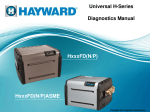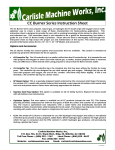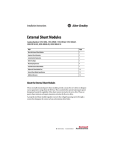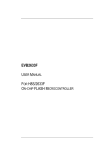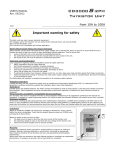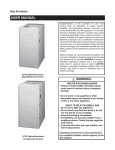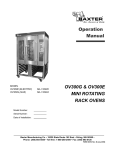Download Universal H-Series Heater - Troubleshooting Guide
Transcript
Universal H-Series Troubleshooting Guide © 2010 Hayward Industries Table of Contents Important Safety Instructions Page 1 BD Code Pages 30-31 Sequence of Operation Pages 2-3 EE and CE Codes Page 32 Electric and Gas Connections Pages 4-5 IO and SB Codes Page 33 Control Hookup Pages 6-7 SF and HS Codes Page 34 Gas Pressure Testing Pages 8-9 HE and PF Codes Page 35 Control Board Connections Page 10 HF Code Page 36 Fuse Board Connections Page 11 LO Code Pages 37-40 Fuses Page 12 IF Code Pages 41-43 Heater will not power up Pages 13-20 AC Code Page 44 Open FC1 and/or FC2 Fuse Pages 21-22 AO Code Page 45-46 Open FC3 and/or F1 Fuse Pages 23-26 Flow Charts Pages 47-52 Open FC4 Fuse Pages 27-28 Wiring Schematic Page 53 Diagnostic Codes Page 29 Wiring Diagram Page 54 Safety Warning ! High Voltage Electrocution Hazard Hazardous voltage can shock, burn, cause serious injury and or death. To reduce the risk of electrocution and or electric shock hazards: • Only qualified technicians should attempt repairs. • Replace damaged wiring immediately. • Insure Heater is properly grounded and bonded. Page 1 UHS Sequence Of Operation The control continually compares the Set Temp to the actual water temp. When the water temp is 1° below the set point the sequence starts. 1. The control checks for open Blower Vacuum Switch 2. Blower starts pre-purge cycle as the igniter heats up (20 Sec). 3. The Control checks for a closed Blower Vacuum Switch. 4. At proper Igniter temp a 4 second trial begins. Gas valve opens and monitors flame sense. The blower will turn off for one second. The Igniter is de-energized at flame sense or at completion of 4 sec trial. If the flame is sensed, The Blower Vacuum Switch, Control Loop, Temp Sensor & Flame Sensor are constantly monitored during call for heat. 5. When set temp is reached, the control ends the call for heat. The gas valve is de-energized, flame is extinguished. 6. The blower will operate for a 30 second post purge. Page 2 UHS Sequence Of Operation Failure to Light – Retry Sequence 1. Gas Valve de-energizes, 30 second blower post purge. 2. Starts over at #2 of heating mode sequence. 3. Retries 3 times until lockout (IF Code) 4. Waits 60 minutes then retries 3 more times 5. Will continue to retry every 60 minutes, until demand for heat is stopped. Note: When making keypad entries of any type there may be a 5-10 sec delay for certain situations. Page 3 UHS Electrical and Gas Connections (Beginning Sept 08) Located on both the left and right side of the heater cabinet. Gas Supply High Voltage Low Voltage Bonding Lug Page 4 Electrical & Control Connections (Beginning Sept 08) 120 VAC or 240 VAC Connection Three Wire Remote Connection: Orange (Pool), White (24V), and Red (Spa). Ground Two Wire Remote Connection: Orange (Pool) and White (Common) Page 5 Control Hookup (Through August 08) Control hookup located outside control box. Two Wire Hook up: Orange (Pool) and White (24v) Three Wire Hook up: Orange (Pool), White (24v), and Red (Spa) Page 6 Control Configuration- Two wire Step 1: Press the Mode button to place the heater in Standby Mode. Step 2: Hold the Mode and Down Arrow buttons simultaneously for 3 seconds for Bypass operation. “bo” will be displayed on the screen. Step 3: Heater must then be in Spa or Pool Mode for operation. The heater will fire when instructed by the external control. Note: 104° maximum temperature. Page 7 Gas Pressure Testing Measure the inlet Static Pressure Step 1: (valve off) and Load Pressure (valve on / energized). The Static and Load values should be within the levels listed on the Data Plate, example on Page 9. Step 2: Measure the outlet Manifold Pressure (valve on / energized). Manifold reading should be between 1.8”- 2.0” w.c for Natural or 6.8”- 7.0” w.c for Propane. Refer to Installation Manual for proper gas line sizing. Page 8 Gas Pressure Testing Remove plug Step 3: Turn clockwise to increase pressure. If inlet pressures are correct and the Manifold Pressure is low or high, adjust the Manifold Pressure at the Gas Valve. Heater Data Plate Note: Never adjust valve if incoming pressure is not correct. Page 9 Integrated Control Board (ICB) Connections Display 3A Fuse (E7) (F1) Temp. Sensor Low Voltage R&C (E2) (E12 , E13) Flame Sensor Gas Valve and Safety Switches (E4) Remote Control (E11) (E1) High Voltage (E10) Igniter Blower/Inducer (E3) (E6) Page 10 Fuse Circuit Board Connections Power Connection for junction boxes. (after Aug 08) (P1) Terminal block for field wiring connections. (TB1) (through Aug 08) Transformer Primary (P3) Low Voltage (P5) High Voltage (P6) Transformer Secondary (P4) 3a 3a Configure heater for 240 VAC or 120 VAC by installing correct plug. (P2) Page 11 Fuses FC1 and FC2 fuses protect the primary input voltage. These fuses blow due to a shorted Fuse Board, shorted Transformer, improper or excessive voltage. 3A 3A The FC4 fuse protects the transformer (120VAC secondary output voltage) from a failed Blower, Igniter, or ICB. The FC3 fuse protects the transformer 24VAC secondary output voltage. Situations that will cause this fuse to blow include: •Short between FC3 to R & C on the ICB. • Any short to ground at the E1 connector (external remote terminal) on the ICB or 24 VAC circuit. Page 12 Troubleshooting: Heater will not power up Step 1: Verify incoming voltage to heater is present (110-125 or 220-245 VAC), if voltage is present, proceed to Step 2. Otherwise, correct incoming line power to heater. Models Prior to August 2008 Models After August 2008 Page 13 Troubleshooting: Heater will not power up Step 2: Verify Voltage Selector Plug matches incoming line power. Step 3: Inspect Fuse Board wiring and ensure all plugs are securely fastened to board. Page 14 Troubleshooting: Heater will not power up Step 4: Verify that FC1 and FC2 Fuses are not open. Check incoming voltage at bottom of both fuses (Fig. A) and out going voltage at top of both fuses (Fig. B), if no voltage present at top of both fuses, remove fuses from the Fuse Holders and measure continuity across each Fuse (Fig. C). Fig. A Fig. B Continuity Fig. C If Fuses are open, proceed to Page 22. Otherwise, reinstall the Fuses and continue to Step 5. Page 15 Troubleshooting: Heater will not power up Step 5: Disconnect plug from P4 connector from Fuse Board. Measure for 22-28 VAC between pins 1 & 2 of plug from Transformer and 110-125 VAC between pins 4 & 6. If either voltage is incorrect, proceed to Page 22. Otherwise, proceed to Step 6. Page 16 Troubleshooting: Heater will not power up Disconnect plug from P5 connector on Fuse Board and measure for low voltage (22-28 Step 6: VAC) between R & C pins of P5 receptacle on Fuse Board. If voltage is not present, proceed to Step 7. Otherwise, proceed to Step 8. Measure for low voltage (22-28 VAC) between P5 C pin and bottom of FC3 fuse. If Step 7: voltage is not present, replace Fuse Board. Otherwise, measure for low voltage between P5 C pin and top of FC3 fuse. If voltage is not present check for blown fuse. If fuse is blown proceed to Page 12, if voltage is present proceed to Step 8. Page 17 Troubleshooting: Heater will not power up Step 8: Inspect ICB wiring and ensure all plugs are securely fastened. If wiring is OK and plugs are securely fastened, proceed to Step 9. Page 18 Troubleshooting: Heater will not power up Step 9: Verify low voltage (22-28 VAC) to ICB between R & C terminals. If voltage is incorrect, replace the Wire Harness. If voltage is correct, proceed to Step 10. Page 19 Troubleshooting: Heater will not power up Step 10: Verify that F1 Fuse (3 AMP) on ICB is not open by measuring continuity across the Fuse. If fuse OK, proceed to Step 11. If fuse is blown, proceed to page 24. Verify 22 – 28 VAC is present between COM and AC terminals on ICB board. If Step 11: voltage is present and display is blank, replace Display Board. If voltage is not present, replace ICB. Page 20 Troubleshooting: Open FC1 and/or FC2 Fuses Step 1: Verify that 120 VAC Voltage Selector Plug is NOT installed with a 240 VAC field power supply. If correct plug is installed, proceed to Step 2. If incorrect, turn the power off and install the 240 VAC plug. Then replace FC1 and FC2 Fuses. Page 21 Troubleshooting: Open FC1 and/or FC2 Fuses Step 2: Check for faulty Transformer wiring and ensure the insulation on the wiring is not worn. Remove P4 and P3 plugs. Measure Transformer for resistance of Step 3: 1.9 - 2.9 ohms between Black to Brown wires and between Orange to Yellow wires of P3. If resistance is out of range, replace the Transformer. Page 22 Troubleshooting: Open FC3 and/or F1 Fuse Step 1: Check low voltage wiring / connections for worn insulation or pinched wiring. Page 23 Troubleshooting: Open FC3 and/or F1 Fuses Step 2: Inspect Gas Valve wiring and ensure insulation is not worn. If wiring is OK, proceed to Step 3. Page 24 Troubleshooting: Open FC3 and/or F1 Fuses Step 3: Measure resistance across Gas Valve terminals (greater than .5 ohms) and between each terminal to Ground for short (there should be no continuity between either terminal to ground). If a short exists (less than .5 ohms), replace the Gas Valve. Otherwise, proceed to Step 4. Page 25 Troubleshooting: Open FC3 and/or F1 Fuses Step 4: Check for faulty ICB wiring and ensure insulation on wiring is not worn. If wiring is OK, replace the ICB. Page 26 Troubleshooting: Open FC4 Fuse Step 1: Inspect the Igniter and Blower Wiring and ensure the insulation is not worn. If wiring is OK, proceed to Step 2. Otherwise, replace the defective component(s). Page 27 Troubleshooting: Open FC4 Fuse Step 2: Disconnect the Igniter Plug from the ICB and measure resistance across the Igniter. Resistance should be 10.9 – 19.7 ohms @ 77 degrees. If resistance is out of range, replace the Igniter. If OK, proceed to Step 3. Step 3: Disconnect the Blower Plug from ICB and measure the Blower resistance. Resistance should be 8-9 ohms from Black to Red wires and White to Blue wires. If resistance is out of range, replace the Blower. Otherwise, proceed to Page 30. Page 28 Diagnostic Codes Below is a list of all Diagnostic Codes for the UHS Heater. Troubleshooting Steps for each Code are covered on the following pages. Diagnostic Code Description AC Blower Vacuum Switch closed AO Blower Vacuum Switch open BD Bad board or secondary high voltage fault CE Communication Error Between Control Module and Display Interface Assembly EE Bad board HE Rapid water temperature rise HF Flame present with Gas Valve not energized. HS Maximum return water temperature exceeded. IF Ignition Failure IO Igniter Failure LO Water Pressure Switch, Vent Pressure Switch, or Temperature Limit Switch Fault PF Voltage polarity reversed, low voltage detected SB Keypad failure SF Temperature Sensor (thermistor) input failure Page 29 Service Light On: BD Code Step 1: BD Code: Bad Board or Secondary High Voltage Fault. Remove FC4 Fuse and measure continuity. If Fuse is blown, go to Page 27 (Open FC4 Fuse). If OK, proceed to Step 2. Step 2: Disconnect plug from P6 connector of Fuse Board and measure for 110-125 VAC across Pins 3 and 5 of P6 receptacle on Fuse Board. If OK, proceed to Step 3. Otherwise, go to Step 4. Page 30 Service Light On: BD Code Step 3: Disconnect plug from E10 connector of ICB and measure for 110 -125 VAC across pins 1 and 3 of plug on Wire Harness. If 110-125 VAC is present, replace the ICB. Otherwise, replace the Wire Harness. Step 4: Disconnect plug from P4 connector of Fuse Board and measure for 110 -125 VAC between pins 4 and 6 of plug from Transformer. If 110-125 VAC is present, replace the Fuse Board. Otherwise, replace the Transformer. Page 31 Service Light On: EE and CE Codes EE Code: “EEPROM Error” Defective ICB board. Replace ICB. CE Code: “Communication Error” between ICB and display board. Error may be cleared by cycling line power off and on. Otherwise, inspect Display Interface ribbon cable and ensure plug is securely attached to ICB. Front Back ICB Display Board If Display Interface ribbon cable and connector plug is OK, replace the Display Interface Assembly. If code is still present, replace the ICB. Page 32 Service Light On: IO and SB Codes IO Code: “Igniter Open” Inspect Igniter wiring, ensure Igniter plug is securely attached to the ICB. Verify Igniter ohm resistance (10.9-19.7 Ohms). If wiring damaged and/or ohms resistance is out of range, replace the Igniter. SB Code: “Stuck Button” requires the Bezel/Keypad assembly to be replaced. Page 33 Service Light On: SF and HS Codes Step 1: SF Code: “Sensor Failure” Inspect Temperature Sensor (thermistor) wire, make sure sensor is plugged into ICB securely. Measure resistance between black wire and each red wire, the Temperature Step 2: Sensor resistance should be the same (10k ohms at 77 degrees). If readings are significantly different from each other, replace the temperature sensor. Otherwise replace the ICB. HS Code: “High Temperature Sense” If water temperature exceeds 105°F the heater will shut down and go into lockout. Automatic restart is 2 minutes after water temp drops below 105°F. Page 34 Service Light On: HE and PF Codes HE Code: “Heat Rise Excessive” Inlet water temperature exceeds 5°F in a 5 second period. This is interpreted as a superheated water condition. If the control detects this condition 3 times, it will lock out and will require a power-cycle to reset. “Polarity Failure” This code will display if 120V polarity is reversed, low PF Code: voltage is detected, or if the ground path is not sufficient. Reset is immediate after error is corrected. Page 35 Service Light On: HF Code HF Code: “Heat or Flame Sensed” Heat sensed when gas valve should be “OFF”. If flame is sensed with the gas valve off, the control will go into lockout. The blower will continuously run until error condition is corrected. When corrected, control will run blower for 5 seconds then automatically restart heater after 2 minutes. Reset heater, cycle line power off and on. If the code is still present, the Gas Valve is defective and needs to be replaced. Page 36 Service Light On: LO Code Step 1: LO Code: “Limit Open” Verify pump is running and adequate water is flowing through heater. LO Code is normal when the pump is turned off. Step 2: Inspect Water Pressure Switch wiring and ensure Wire Harness terminals are securely fastened to the spade terminals on the Water Pressure Switch. Remove wires from Water Pressure Switch and measure continuity across the Step 3: terminals while pump is running. If open, replace Pressure Switch. Otherwise, go to Step 4. Page 37 Service Light On: LO Code Step 4: Certain applications will require the adjustment of the Pressure Switch, refer to section of the installation/service manual Water Pressure Switch Test / Adjustment Procedures. Step 5: Inspect Temperature Limit Switch Wiring and ensure wire harness terminals are securely fastened. Page 38 Service Light On: LO Code Step 6: Measure continuity across the Temperature Limit Switches. If open, replace the Temperature Limit Switch(s). Applies Only To Indoor Installations Step 7: Inspect the Vent Pressure Switch Wiring and Hose connections. Ensure Wire Harness is securely fastened and tubing is attached to Blower and Vent Pressure Switch. If OK, proceed to Step 8. Page 39 Service Light On: LO Code Applies Only To Indoor Installations Step 7: Ensure that flue is not blocked or restricted. See indoor vent sizing requirements in Installation Manual. Step 8: Remove wires from Vent Pressure Switch and measure continuity between terminals. While heater is running, measure continuity across the Vent Pressure Switch. If open, replace Vent Pressure Switch. Page 40 Service Light On: IF Code Step 1: IF “Ignition Failure” Ensure main gas shutoff outside the heater is open and that the Gas Valve inside the heater is in the “ON” position. Step 2: Inspect Flame Sensor and Gas Valve wiring and ensure wire harness is securely fastened to the terminals. Step 3: Ensure Gas Static, Load and Manifold pressures are correct. See Page 8. If OK, proceed to Step 5, Otherwise proceed to Step 4 Page 41 Service Light On: IF Code Step 4: Measure for 22-28 VAC across Gas Valve during trial for ignition. If 22-28 VAC is present and Gas Valve does not open with manometer connected to valve, replace Gas Valve. See Page 8 for reference. If 22-28 VAC is not present, replace the ICB. Step 5: For models manufactured prior to 4/14/2009 Verify which flame sensor is installed. If 3" flame sensor installed, replace to 5" flame sensor. Part # IDXLFLS1930 Page 42 Service Light On: IF Code Step 6: Remove and inspect Gas Orifices and Burners for blockage. NOTE: Check for excessive moisture in combustion chamber. Determine possible causes; roof run-off, sprinklers, etc.. Page 43 Service Light On: AC Code Step 1: AC Code: “Air Switch Closed” Blower vacuum switch closed when expected open. Disconnect wires and tubing from switch, measure continuity between terminals on switch, if continuity exist, replace switch. Step 2: With heater off, If blower continues to run, replace ICB. Page 44 Service Light On: AO Code Step 1: Step 2: Check for faulty Blower and Blower Vacuum Switch Wiring, Tubing, and Connections. Ensure Voltage Selector Plug is configured for correct field supplied voltage. Page 45 Service Light On: AO Code Step 3: Disconnect Blower Plug from ICB and measure resistance across Blower windings for 8 to 9 ohms from Black to Red Wires and White to Blue Wires. If resistance is out of range, replace the Blower. If OK, proceed to Step 4. Step 4: Disconnect Blower Plug from ICB and generate a call for heat. While in pre-purge, measure for 110-125 VAC across Pins 1 & 2 of inducer on ICB. If 110-125 VAC is not present, replace the ICB. If 110-125 VAC is present and Blower is running, replace the Blower Vacuum Switch. Page 46 Flow Chart - Heater will not power up Heater will not power up Is 22-28 VAC present on P5? Yes No Is all ICB wiring secure and correct? Yes Is 22-28 VAC present on terminals R & C of Control Board? No Yes Go to “Blown FC3 and/or F1 fuse” section. No Is field supply voltage present on P1? Replace Wire Harness Yes Replace ICB. Is all Fuse Board wiring secure and correct? Yes Is FC1 or FC2 Fuses Open? No Correct wiring. Problem Solved. If not, call Tech Support (908) 355-7995 Replace Wire Harness Correct field wiring to heater. Replace Fuse Board. Replace Transformer. Yes Go to “Open FC1 and/or FC2 fuse” section (Page 21) No Is proper Voltage Selector installed? No No Replace Display Board No Yes Is field supply voltage present in junction box? Yes (Page 23) Is 22-28 VAC present on pins 1&4 of E7? Yes No Go to “Open FC3 and/or F1 fuse” section No No Correct wiring. Is FC3 Fuse blown? Yes Is F1 Fuse Open? Install correct plug. Yes No Is 110125 VAC present at P4? Yes Is 22-28 VAC present on pins 1&2 of P4? Yes No Replace Transformer. Page 47 Flow Chart- Blown FC1 and/or FC2 Fuse Blown FC1 and/or FC2 Fuse Is proper voltage selector installed? Yes Is Transformer wiring damaged, pinched, or worn? No Install proper voltage selector. Yes Correct / repair Transformer wiring Problem Solved. If not, call Tech Support (908) 355-7995 No Is Transformer resistance out of range? Yes Replace Transformer No Flow Chart- Blown FC3 and/or F1 Fuse Blown FC3 and/or F1 Fuse Is Gas Valve wiring damaged, pinched, or worn? Yes Correct / repair Gas Valve wiring No Is resistance on Gas Valve less than .5 ohms? No Yes Replace Gas Valve. Problem Solved. If not, call Tech Support (908) 355-7995 Is Control Board wiring damaged, pinched, or worn? Yes Correct / repair board wiring. No Replace ICB. Page 48 Flow Chart- BD Code BD Code Is the FC4 Fuse open? Go to “Open FC4 Fuse” Section Yes (Page 27) No Is 110-125 VAC present on pins 3 & 5 of P6 receptacle? Yes Is 110-125 VAC present on pins 1 & 3 of E10 Plug? (Page 31) Yes Replace the ICB. (Page 30) No No Replace the Wire Harness. Replace the Transformer. No Is 110-125 VAC present on pins 4 & 6 of P4 Plug? (Page 31) Yes Replace the Fuse Board. Problem Solved. If not, call Tech Support (908) 355-7995 Page 49 Flow Chart- LO Code LO Code Is the pump running? Yes Is water flow above minimum required? Yes Is the Water Pressure Switch closed? Yes (Page 37) No Turn the circulation pump on. No Backwash or clean the filter. No Adjust Water Pressure Switch if needed. refer to the pressure switch adjustment section of the installation / service manual. LO Code Cleared? Indoor Installations Only Is the Vent Pressure Switch closed? (Page 39) No Is the flue blocked or restricted? Yes Are the High Limit Switches closed? (Page 38) No Replace the High Limit Switches No No Replace the Water Pressure Switch Replace the Vent Pressure Switch Problem Solved. If not, call Tech Support (908) 355-7995 Page 50 Flow Chart - IF Code IF Code Gas supply shutoff valves and Gas Valve turned on? No Yes Is inlet gas supply pressure between min. and max.? (Page 8) No Yes Is the Flame Sensor plugged in and 5” in length? (Page 42) Yes No During 4 sec trial for ignition, is 22-28 VAC present at Gas Valve and 110-125 VAC at Igniter? (Page 42) Yes No Turn on Gas valves. Adjust the gas pressure (Page 8) Plug in or replace the Flame Sensor. Inspect Orifices and Burner Tubes (Page 43) Replace the ICB. Yes Is the Manifold gas pressure correct? (Page 8) No Problem Solved. If not, call Tech Support (908) 355-7995 Inspect Combustion Chamber for moisture Adjust Manifold gas pressure. (Page 43) (Page 9) Page 51 Flow Chart - AO & AC Code AO Code Is the Blower Vacuum tubing and wiring. OK? (Page 45) No Replace damaged parts. Yes Is the correct Voltage Selector Plug installed? Yes (Page 45) Is the Blower resistance within range? Yes (Page 46) No No Install correct plug. Replace the Blower. Is 110-125 VAC present at Blower relay? (Page 46) Yes Replace the Blower Vacuum Switch. No Replace the ICB. Problem Solved. If not, call Tech Support (908) 355-7995 AC Code Is the Blower relay open? (Page 44) Yes Replace the Blower Vacuum Switch. No Replace the ICB. Problem Solved. If not, call Tech Support (908) 355-7995 Page 52 L / L1 240v plug N / L2 Schematic 120v plug P1/2 P1/1 P2 / T4 P2 / T2 P2 / T3 P2 / T1 FWP FWP FC2 Fuse FC1 Fuse circuit # 3 circuit # 1 P3 / T3 P3 / T4 120v P4 / C P4 / 24v circuit # 2 FC3 Fuse E12 / R E10 / H P4 / N circuit # 4 FC4 Fuse FWP Relay P6 / N ICB E10 / N E3 L Igniter E3 R E6 R Blower E6 W F1 / 3 Amp Fuse Relay Display Board 120v P6 / H Note: Integrated Control Board COM 24 VAC P4 / 120v P5 / R E11/6 E11/5 E11/4 E11/3 E11/1 E11/2 E7 AC (opt) VPS n/c BVS n/o WPS n/o Relay Hi Limit n/c ICB Hi Limit n/c E13 / C Gas Valve FWP 120v Isolation Transformer 24v P5 / C P3 / T1 P3 / T2 Temp Sensor - (ohms)Ω between black and each red should read the same. 77°F = 10,000 Ω 1. The Igniter, Blower and Gas Valve relays are an integral part of the ICB (Integrated Control Board) 2. Wiring internal to the ICB and temp sensor are indicated by a dotted line, i.e. …………….. 3. Isolation transformer creates 4 circuits as shown for troubleshooting. Bezel Ribbon Cable Continuity 1 & 4 Mode Switch 1 & 3 Temp Set Red (up) 1 & 2 Temp Set Blue (down) Top 4 3 2 1 Page 53 Wiring Connection Diagram Page 54


























































